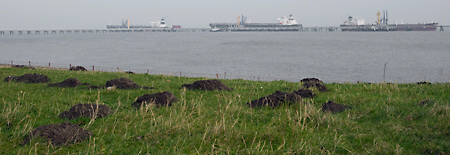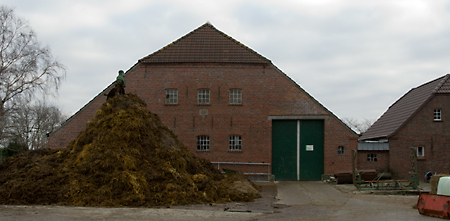Fractal patterns of mudflats at low tide,
frenetic mole activity in a dike,
and manure heap composition
studied during the Winter solstice in a northern land.
a multi-disciplinary dialog
Posted by Birgit Zipser on January 11th, 2008
Fractal patterns of mudflats at low tide,
frenetic mole activity in a dike,
and manure heap composition
studied during the Winter solstice in a northern land.
Filed in landscape,photography

Sorry, I removed an AP processed version (layer difference mode) because it looked too garish against the mute colors of the other images.
The mole heaps make a wonderful contrast to the severe horizontals of the water and ships. And the echoing of manure and barn made me laugh out loud.
But of course the first one is the most beautiful. I can’t decide this evening whether I’m going for beauty or chuckles or design. What choices!
Birgit,
I’m assuming these pictures are from your home town, like last time. Other than these, I think I’ve only seen your photos of the dunes by Lake Michigan, which I know you love. I’m wondering a couple things. First, do you see these places at all differently because you are now photographing them? And second, are you only photographing these places you know well, or do you just feel these are your most important images?
June and Steve,
You are both very kind to help me along with my rather speechless (even terser than a Haiku) struggle to understand where I am and where I am going.
June,
I love you for expressing your thoughts and feelings about the three different pictures, helping me to understand, do I dare say it – their essence.
Steve,
Do you see these places at all differently because you are now photographing them? They are as different as can be except for their most recent civilization between 100 and 200 yrs ago and their crows or ravens –
(1) Muddy ocean water that on rare wind still, part sunny part cloudy days shimmers like a giant mirror compared to the clear waters of the Great Lake ranging from turquoise to purple.
(2) Heavy bombing of the German submarine naval base during World War II, that afterwards, allowed a child to freely roam, the back then, abandoned coast line excepting wood strips behind the dike where, still nowadays, live bombs are found. My initial wonderment of the Michigan coastline not ravaged by modern warfare.
(3) The countryside near my hometown consists of moist meadows, drained by ditches, with grazing cattle while the dunes in the summer are desert-like in their dryness. Brick, rather than wooden houses.
Are you only photographing these places you know well, or do you just feel these are your most important images?
(1) I like water and the North Sea bay and Great Lakes are the two bodies of water where I am spending time. (2) Making peace with my childhood before my hometown has been (a) fully manicured, already, there are no cows grazing on the dikes, and (b) I lose my human ties. (3) I am snapping the movements of children and hope to eventually combine them with landscapes.
Birgit,
My question wasn’t very clear; I meant to ask whether you see these places differently than you would if you weren’t photographing. But the way you took it, comparing the two locations, is also interesting and gives me new insight into why you like the Great Lakes so well. And I’m led to suspect that your photography does indeed play a role in how you see and think about them now.
Steve,
whether you see these places differently than you would if you weren’t photographing.
I don’t think so. I often photograph what I previously saw and would like to capture. For example, I asked my mother to drive by farmhouses and it took three trips until I found the shot that I wanted. I am still hoping to be able to capture the silver mirror-look of the bay some day.
But when I do see something that appeals to me (planned or serendipously), I usually take lots of pictures, perhaps because I still feel inexperienced in getting exactly what I want.
Am I now on the right track?
it took three trips until I found the shot that I wanted.
Ah, but that means you were looking closely and evaluating against some visual idea in your head. That’s a different experience than just viewing absent-mindedly. Whether your ideas are based on memories, clichés, paintings, or whatever, it seems there’s something you want your photographs to express. To me, that’s what thinking artistically means.
Taking lots of pictures is good, if you look at them later and learn from them. If one were only taking pictures and not viewing them–which happens quite a lot with photographers–I think fewer, more considered pictures is better. Just my opinion.
Birgit,
The sense of the (well-known) place has become, as you know, very important to me. So I’m interested to hear that you are working off memory, present observation, and, as Steve has wangled out of you, multiple observations. I’m not saying this well, but I think it’s the combination of familiarity, memory, close observation and artistic consideration –all go into making the photos outstanding.
Steve,
I am glad about his conversation. When I first read your last question, my immediate response was that I was taking pictures as an emotional response. Then, I remembered that I did do some planning. But I was still on the wrong track. It is all of those, the artistic black box of my mind.
June, both you and Steve
are helping to make me more confident.Thank you.
June,
The sense of the (well-known) place has become, as you know, very important to me.
that you succeed in translating to others .
Birgit:
A few drive-by thoughts…
You have canted the horizon slightly to the left in your mud flat image; this in the interests of facilitating the flow to the sea. Imagine canting one’s camera this way and that and seeing in the viewfinder very different worlds resulting from one’s induced slopes and angles. Hold the camera horizontally and the glass retains its water, tilt the camera and the water spills.
I do have to ask about your marina in an earlier post. It is almost identical to those here, with the exception, perhaps, of boat names being in another language. Did the power of association – the “well known place” – influence your decision to include this, rather than one along Lake Michigan? The point that I think that I may be making is that your shots of the dunes are about a resonance between yourself and that stretch of shoreline – an affinity toward that kind of situation. Your home images seem to be more about a life lived, about a human presence to which you did and do contribute. Yet you appear to be standing back to take your photographs almost like a tourist. Is that the result of a separation brought by time? I’ve been indulging in a kind of tin-horn photo-psychoanalysis of late, with you and Steve my most recent victims. But your photo essays make me wonder what I would do with a camera back in my own home town.
Jay,
On the technical side, this was an attempt to capture the grim colors seen also in some of Paula M-B’s landscapes.
Jay,
I am not a boating person, I hike in as much solitude as I can find unless I am in NYC. I know nothing about marinas on the Great Lakes. The German post World War II marina lies on a road, put there by the ‘Allies’ to obstruct the submarine harbor, on the way to my dike walk.
The point that I think that I may be making is that your shots of the dunes are about a resonance between yourself and that stretch of shoreline – an affinity toward that kind of situation. that seems to be the case.
I have shown a habit of presenting ‘travelogues’. On 06_01_07, when I first tried out my new and better camera, Karl commented on an early MI dune post: These look like normal rather than “art” photos. I wonder if simply putting them into black and white would make them seem “arty”?
Now, you use the modifier ‘almost’ Yet you appear to be standing back to take your photographs almost like a tourist.. It seems that I have made progress in the last half year as a photographer.
One of the differences between my recent dune pictures and my northern Germany pictures is my available time, solitude and mobility. In Frisia, I am on short visits depending on my almost 90 year old mother for driving. I learned driving in Manhattan and yet, have never yet dared driving in Germany, my mother’s originally fierce driving competence still inhibits me.
And you are right about the nostalgia – remnants of a life lived.
Birgit:
I see your photography as residing on the perception side of Art and Perception. The art comes, but for it to be satisfying it should stem from some degree of affection.
I remember sub bases in Holland: hulking concrete monoliths,immovable against the shifting sands. That was back in ’53. For all I know, they’re still there. I imagine that they would be very hard to photograph effectively.